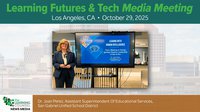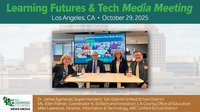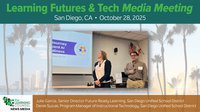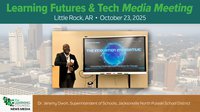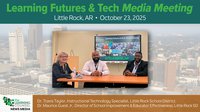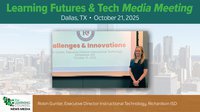This can be considered a postulate or axiom. (Depending on one's perspective.) It can be worded in different ways, but this is the central a priori existential truth of education in general. It is what drives the commitment of time, effort, and budget of both the institution and the intended beneficiaries.
We can do this through data driven instruction. (Or more recently “through data informed instruction”.
This is a theory adopted from the world of business. It also drives the commitment of time, effort, and budget of both the institution and the intended beneficiaries.
Make no mistake. I have spent extensive time, effort, and budget throughout a large portion of my career as a believer and evangelist in the church of data. I have taught, trained, and built systems based on the theory. I have done it all; spreadsheets, dashboards, advanced statistics AI powered anomaly detection, and even the fever dream of predictive analytics I even created a mathematical expression as a value calculation: (While statistically novel, it could only support student success as a negative measure with respect to technology investment. A positive result could only be correlated to a single variable which would then need to have proven correlation but causation could never be proven.
Educational ROI = N1 (Where N1 is the number of Students) x Effect/TCO (the Inverse of the percent of FOI expressed as a decimal
These efforts were not badly intentioned]. As a matter of fact, they were barely intentional at all. We were all doing the best with what we had to work with hoping that we could leverage it to help kids. Let’s put that aside for now and have a moment of enterprise level self-reflection about data beginning with clarity about data and where it sits in the perceptual and analytic universe. This is presented as a hierarchy. (Because it is.)
● Data is zero dimension, raw, unorganized facts and figures like numbers, text, or multimedia that are collected for reference or analysis. Data is how we reduce the world to a level that can be efficiently processed by binary digital machines. It is what sits in our spreadsheets, databases, and data warehouses.
● Data to Information: Processing and organizing raw data adds context and meaning, transforming it into information adding various dimensions. Language, images, video, sounds are standards for information. Information is the least common medium of human understanding. It is also the minimum to initiate effective action . AI now allows digital processing of information and information level output using language.
● Information to Knowledge: Applying information through experience and learning leads to knowledge, which helps identify patterns and make predictions. It can also be self validating or correcting through experience. Knowledge requires awareness of time to organise information.
● Knowledge to Insight[1] : Critically analyzing and synthesizing knowledge can lead to moments of insight, revealing a deeper, non-obvious understanding. This not only requires awareness of time, but also the ability to discern perspective with respect to experienced reality. Human heuristics is a function of insight and can be subject to error. While a probabilistic algorithm running on quantum computers might be able to simulate insight.
● Insight to Wisdom[2]: Evaluating and applying insight with a focus on core values, principles, and long-term consequences results in wisdom. Applying the rule that insight is not error free is evidence of wisdom.
I will probably be excommunicated for the next statement.
Education is a uniquely human enterprise where ROI is measured by student success and data alone is woefully inadequate for that task.
The Problem with Data
All data schemas, conventions, formats, and standards are created with the intention to tell a particular story within the boundaries of what a computer could process. K12 education is rife with these in addition to the proprietary schemas of various learning products and specific data required for federal and state agencies related to funding. That said, most of this impressive mass of data was not initially intentionally designed to promote student success. Some of us believed there was a beneficial current that will take our students to living wage employment somewhere in the sea of numbers and demographics. (A beneficial effect is not a property inherent in data.)
Working with data is not a useless exercise as it can be designed to indicate issues through direct and derivative measures, but extrapolating corrective measures still requires the insight of an educator.
This brings me to why we need AI. There are two reasons relevant to this current exercise.
Reason One: The availability of language as the standard descriptive evaluative format that does not require reduction of the student.
Earlier it was stated that data requires the reduction of the student and their activity to parameters of a report, application, or database catalog. There is a more precise and detailed alternative. Humans already have a very precise way of communicating called language. Language has the capability to provide all context and be far more precise than data because of semantics. Not only is there meaning at the word level, but we can structure language with phrases, sentences, paragraphs, papers, stories, etc. Language can convey time as a point, span, or condition that we add to data to provide context, conditions, certainly or the lack thereof.
AI now allows our computing companions to "join the conversation”
And where data may only serve to indicate a problem, language allows for the necessary conversation, consultation, solution testing and iteration necessary to solve. Language is the difference between powerlessly observing a train wreck to solving the train wreck “problem “ once and for all.
Reason Two: Zero Latency Iteration to Mastery
What is the purpose of evaluation?
Are we just trying to create one more spreadsheet?
Is all that effort just to generate numbers for state and federal accountability?
I think we all want to do what’s right for kids. That being the case we hope that evaluation might point us in a direction that helps students. The problem is current systems aren't designed to do that. this is not about blaming a bender because previously we did not have the technology to do something different.
Now that we do, we can do better. We just need to revise how we see the process.
I've heard people who allude to coaching as a model for instruction. The reason for this is easy to observe. It's not a secret.. Coaches iterate to mastery with zero latency.
It’s also a practice of music, dance, and drivers education teachers.
In plain english I am referring to the practice of practice. Practice where every “rep” is observed, mistakes are immediately corrected and technique is iterated to mastery. Anyone who has played a sport, participated in a dance company, or learned a musical instrument at any level has experienced this. The process is simple. Directly observe the individual perform the operation or technique closely enough to observe any errors, immediately interrupt any errors and provide the correct replacement behaviour, continue to practice iterating until mastery is achieved.
Ultimately the learner not only masters the content, but they also master their ability to learn. (News flash: That’s what we are really trying to teach them.) This appears to be a relatively simple process. Why can't every teacher just do that? The answer is relatively simple also. Numbers. In elementary school its the number of subjects the teacher would be expected to teach to mastery, in secondary it is the number of students. This is a problem AI can and has solved already. AI tutoring agents are already available. Agentic “content” will be the next stage.



